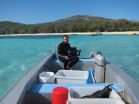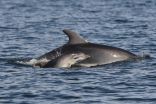(Press-News.org) A species of small fish uses a homemade coral-scented cologne to hide from predators, a new study has shown, providing the first evidence of chemical camouflage from diet in fish.
Filefish evade predators by feeding on their home corals and emitting an odor that makes them invisible to the noses of predators, the study found. Chemical camouflage from diet has been previously shown in insects, such as caterpillars, which mask themselves by building their exoskeletons with chemicals from their food. The new study shows that animals don't need an exoskeleton to use chemical camouflage, meaning more animals than previously thought could be using this survival tactic.
"This is the very first evidence of this kind of chemical crypsis from diet in a vertebrate," said Rohan Brooker, a post-doctoral fellow in the School of Biology at the Georgia Institute of Technology in Atlanta. "This research shows that you don't need an exoskeleton that for this kind of mechanism to work."
The study was published December 10 in the journal Proceedings of the Royal Society B. The study was sponsored by the ARC Centre of Excellence for Coral Reef Studies and the Ecological Society of Australia. The work was done as a part of Booker's doctoral research at James Cook University in Australia.
Anyone who has watched a nature documentary has seen insects that camouflage themselves as sticks, protecting the insects against predators that use vision to hunt for prey. But many animals see the world through smell rather than sight, and cunning critters from among them have adapted clever ways of smelling like their surroundings. A certain species of caterpillar, for example, smells like the plant that it lives on and eats. The caterpillar incorporates chemicals from the plant into its exoskeleton. Ants hunting for the caterpillar will walk right over it, none the wiser.
For the new study, researchers traveled to Australia's Lizard Island Research Station in the Great Barrier Reef, where they collected filefish. To show that filefish smelled like their home coral, the researchers recruited crabs to sniff them out. The filefish were fed two different species of coral; each species of coral is home to a unique species of crab. The crabs were given a choice between a filefish that had been fed the crab's home coral and a filefish that had been fed a coral that is foreign to the crab. The crabs always sought the filefish that had been feeding on the crabs home coral. The filefish smelled so strongly of coral that sometimes the crabs were attracted to the fish instead of coral, when given a choice between the two.
"We can tell that there is something going through the filefish diet that's making the fish smell enough like the coral to confuse the crabs," Booker said.
To see if the chemical camouflage gives the filefish an evolutionary advantage to evade predators, the researchers tested cod to see how they responded to filefish that had been fed various diets. Cod, filefish and corals were put in a tank, with the filefish hidden from the cod. When the filefish diet didn't match the corals in the tank, the cod were restless, suggesting that they smelled food. When the filefish diet matched the corals in the tank, the cod stayed tucked away in their cave inside the tank.
The next step in the project is to learn how filefish can smell like coral without the benefit of an exoskeleton. Some evidence shows that amino acids in the mucus of fish - where much of their smell originates - will match their diet, but much work remains to tease apart this pathway.
"We have established that there is some kind of pathway from filefish diet to filefish odor," Booker said. "This is just the first study. There's a lot of work still to be done to understand how it works."
INFORMATION:
Booker is now working in the lab of Danielle Dixson, an associate professor of biology at Georgia Tech.
This research is supported by the ARC Centre of Excellence for Coral Reef Studies and the Ecological Society of Australia. Any conclusions or opinions are those of the authors and do not necessarily represent the official views of the sponsoring agencies.
CITATION: Rohan Brooker, et al., "You are what you eat: diet-induced chemical crypsis in a coral-feeding fish." (Proceedings of the Royal Society B, December 2014). http://rspb.royalsocietypublishing.org/content/282/1799/20141887
Research News
Georgia Institute of Technology
177 North Avenue
Atlanta, Georgia 30332-0181 USA
@GTResearchNews
Media Relations Contacts: Brett Israel (@btiatl) (404-385-1933) (brett.israel@comm.gatech.edu) or John Toon (404-894-6986) (jtoon@gatech.edu)
Writer: Brett Israel
Researchers at Loyola University Chicago Stritch School of Medicine may have identified a way to assess who is at risk for developing a urinary tract infection (UTI) following pelvic-floor surgery. These findings were reported in the latest issue of PLOS ONE.
Urinary tract infections (UTIs) are the most common type of bacterial infection and have estimated treatment costs exceeding $1 billion a year in the United States. Women who undergo surgery for pelvic-organ prolapse or urinary incontinence are more likely to develop a UTI following the procedure. Clinicians have ...
Three studies presented by University of Colorado Cancer Center researchers at the San Antonio Breast Cancer Symposium 2014 demonstrate the effects of blocking androgen receptors in breast cancer. One shows that, counterintuitively, blocking the action of androgen receptors reduces the growth of estrogen-positive (ER+) breast cancers. The second study found that even triple-negative breast cancers (TNBCs), which are without known hormone drivers and carry the poorest prognosis, are dependent on androgen receptor activation. And the third study finds that targeting androgen ...
The National Science Foundation (NSF) has awarded Kent State University a $300,000 grant for three College of Arts and Sciences faculty members to study how human dynamics across social media and social networks can be modeled. The grant is part of a $999,887 collaboration with San Diego State University and the University of Arkansas.
Professor Jay Lee and Assistant Professor Xinyue Ye of Kent State's Department of Geography and Associate Professor Ruoming Jin of Kent State's Department of Computer Science will use information diffusion, visualization and simulations ...
Dr. Damon Little, Associate Curator of Bioinformatics in the Cullman Program for Molecular Systematics at The New York Botanical Garden, has just published a new study in the journal Genome investigating the use of DNA barcoding to test the authenticity of Ginkgo biloba (G. biloba), an herbal dietary supplement sold to consumers that is supposed to boost cognitive capacity. Unfortunately, herbal supplements on the market are subject to mislabelling, and therefore consumers may not be getting the products and benefits they believe they are getting.
Dr. Little's research ...
Tampa, FL (Dec. 11, 2014) -- Despite emerging evidence otherwise, many college students consider hookah smoking safer than smoking cigarettes, reports a University of South Florida (USF) College of Public Health study published this month by the Centers for Disease Control and Prevention (CDC).
The study, appearing online in the CDC journal Preventing Chronic Disease, examined the prevalence of hookah use and described social and behavioral factors associated with hookah smoking among students at USF, a large urban public university in Tampa, Fla. The research suggests ...
A cold 'sensor' which triggers the skin's vascular response to the cold could represent an exciting new therapeutic target for the treatment of frostbite and hypothermia, according to scientists at King's College London.
Known to be linked to pain sensitivity and currently used in the development of painkillers, this is the first time the TRPA1 gene has been implicated in the response of blood vessels in the skin to cold. Published today in Nature Communications, the research was funded by the British Heart Foundation and the Biotechnology and Biological Sciences Research ...
The rise in tourism, fishing and sea transport between the Iberian Peninsula and the Balearic Islands is compromising the wellbeing of a small population of common bottlenose dolphins living in coastal waters off the Pityusic Islands. This is the conclusion of a study led by the University of Barcelona (Spain), which has, for the first time, counted these mammals in summer and spring, which are crucial seasons for them.
Despite being one of the most common cetaceans in the Mediterranean Ocean, the common bottlenose dolphin (Tursiops truncatus) resides in areas close to ...
The drive for energy efficient homes could increase asthma risks, according to new research.
Led by a team at the University of Exeter Medical School, the research has found that a failure by residents to heat and ventilate retrofitted properties could lead to more people developing the respiratory condition.
Working with leading UK social housing provider, Coastline Housing, the research team assessed data from the residents of 700 properties in Cornwall. They found that people living in more energy efficient homes had a greater risk of asthma, and that the presence ...
Scientists at Brunel University London have found a way of targeting hard-to-reach cancers and degenerative diseases using nanoparticles, but without causing the damaging side effects the treatment normally brings.
In a huge step forward in the use of nanomedicine, the research helped discover proteins in the blood that disguise nanoparticles so they are absorbed into cells without causing inflammation and destroying healthy cells.
Two studies, Complement activation by carbon nanotubes and its influence on the phagocytosis and cytokine response by macrophages and Complement ...
The preventive effect of breast cancer drug 'tamoxifen' remains virtually constant for at least 20 years - with rates reduced by around 30 per cent - new analysis published in The Lancet Oncology reveals.
The IBIS-I trial (International Breast Cancer Intervention Study), led by Queen Mary University of London and funded by Cancer Research UK, examined the long-term risks and benefits of taking tamoxifen to prevent breast cancer in women at high risk of the disease (aged 35-70 years old, primarily with a family history of breast cancer).
During the study* 7,154 pre ...


